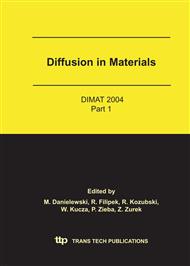p.849
p.855
p.861
p.867
p.873
p.879
p.885
p.891
p.899
Reaction Diffusion in Mo-Si System above the Melting Point of Silicon
Abstract:
The results of direct kinetic measurements and SEM observations on formation of silicide phases in Mo-Si system at temperatures 1400-1700о С are presented in the work. It was shown, that the formation of MoSi2 proceeds by two different mechanisms and accordingly, two types of microstructures are formed: (i) a compact layer (usually with expressed columnar structure) by the reaction diffusion mechanism; and (ii) separated fine grains by crystallization in the volume of saturated Me-Si melt. A model of product formation is offered which allows to calculate the relative contributions of the two mechanisms of disilicide phase formation at various stages of interaction and to estimate the role each of them in the total process.
Info:
Periodical:
Pages:
873-878
Citation:
Online since:
April 2005
Keywords:
Price:
Сopyright:
© 2005 Trans Tech Publications Ltd. All Rights Reserved
Share:
Citation:


